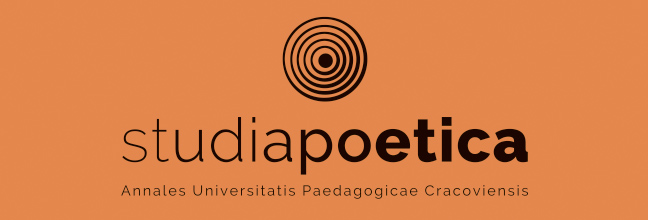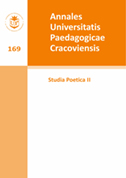Semiotyka narracji architektonicznej Jacka Sala w mieście Kielce
Main Article Content
Abstrakt
Semiotics of architectural narrative by Jack Sal (Poland)
The article is an anthropological interpretation of the monument White/Wash II - a Memorial for the Victims of the 1946 Pogrom designed by Jack Sal and erected in Kielce, the town where the pogrom took place. The analysis includes functions and communicational relationships of the monument in the urban architecture and artistic space. The cognitive process revealed that the image of a house is an axiological center of the artist’s architectural narrative. Thus, the polymorphism and polysemy of the monument are perceptible. The monument allusively invokes the archetype of a house, the symbol of the Jewish “shtetl”. It also assumes the form of a symbolic memory sign - a medallion - with an outline of the house and the backstreet where the pogrom took place in the postwar history of the Jewish nation. Jack Sal’s monument develops an innovative language of public discourse, and being a cultural text, it creates a code that indicates the values which are manifested in the urban space - living and building - representing the idea of a family nest, an existential expression of a human community. The artist’s symbolic narrative refers to the subjective, personal consciousness of viewers and their hermeneutic intuition which allows for recognizing the values common to people of different nations, times and cultures.
Downloads
Article Details
Wydawca „Annales Universitatis Paedagogicae Cracoviensis. Studia Poetica” jest upoważniony do korzystania oraz do rozpowszechniana wszystkich opublikowanych w czasopiśmie materiałów na podstawie umowy licencji niewyłącznej nieograniczonej w czasie - zawartej uprzednio na czas nieoznaczony każdorazowo z autorem/ką konkretnego utworu na określonych w tamtejszej umowie polach eksploatacji.
POLITYKA OTWARTEGO DOSTĘPU
„Annales Universitatis Paedagogicae Cracoviensis. Studia Poetica” to czasopismo o otwartym dostępie, a cała jego zawartość jest dostępna bezpłatnie dla użytkowników i instytucji na zasadach Creative Commons Attribution CC-BY 4.0. (uznanie autorstwa). Użytkownicy/ki mogą czytać, pobierać, wykonywać kopie, rozpowszechniać, drukować, wyszukiwać lub linkować do pełnych tekstów artykułów w tym czasopiśmie bez uprzedniej zgody wydawcy lub autora/ki pod warunkiem podania źródła dostępu i autorstwa danej publikacji. Jest to zgodne z definicją otwartego dostępu BOAI (http://www.soros.org/openaccess).
Bibliografia
Bauman Z., Tożsamość. Rozmowy z Benedetto Vecchim, tłum. J. Łaszcz, Gdańsk 2007.
##plugins.generic.googleScholarLinks.settings.viewInGS##
Burzyńska H., Miejsca, strony, okolice. Przyczynek do fenomenologii przestrzeni, Kraków 2006.
##plugins.generic.googleScholarLinks.settings.viewInGS##
Capra F., Punkt zwrotny. Nauka, społeczeństwo, nowa kultura, tłum. E. Woydyłło, przedmowa A. Wyka, Warszawa 1987.
##plugins.generic.googleScholarLinks.settings.viewInGS##
Dolistowska M., Miasta wielokrotnego zapisu – ikonosfera nowych przestrzeni tożsamości, „Czasopismo Techniczne. Architektura” 2010, z. 7–A/2.
##plugins.generic.googleScholarLinks.settings.viewInGS##
Domańska E., Po-postmodernistyczny romantyzm (Sensitivism – „nowa” filozofia historii – Franklin R. Ankersmit), „Kultura Współczesna” 1996, nr 1–2.
##plugins.generic.googleScholarLinks.settings.viewInGS##
Gross J. T., Strach. Antysemityzm w Polsce tuż po wojnie. Historia moralnej zapaści, Kraków 2008.
##plugins.generic.googleScholarLinks.settings.viewInGS##
Heidegger M., Budować, mieszkać, myśleć. Eseje wybrane, wybór, oprac. i wstęp, K. Michalski, tłum. K. Michalski i in., Warszawa 1977.
##plugins.generic.googleScholarLinks.settings.viewInGS##
Pietrzyk A., Spiżowe persony Łodzi. Pomniki galerii wielkich łodzian widziane przez pryzmat antropologii codzienności, [w:] Wizualność miasta, Wytwarzanie miejskiej ikonosfery, red. M. Krajewski, Poznań 2007.
##plugins.generic.googleScholarLinks.settings.viewInGS##
Rewers E., Post-polis. Wstęp do filozofii ponowoczesnego miasta, Kraków 2005.
##plugins.generic.googleScholarLinks.settings.viewInGS##
Szkic sytuacyjny miejsca pogromu Żydów w Kielcach 4 lipca 1946 r., [w:] Antyżydowskie wydarzenia kieleckie 4 lipca 1946 roku, dokumenty i materiały, oprac. S. Meducki, Z. Wrona, Kielce 1992.
##plugins.generic.googleScholarLinks.settings.viewInGS##

